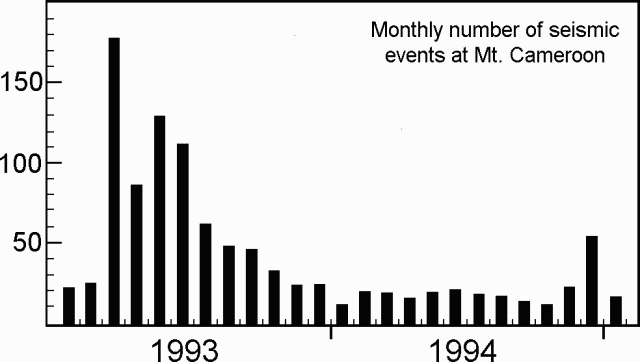Report on Cameroon (Cameroon) — February 1994
Bulletin of the Global Volcanism Network, vol. 19, no. 2 (February 1994)
Managing Editor: Richard Wunderman.
Cameroon (Cameroon) Increased seismicity in 1993
Please cite this report as:
Global Volcanism Program, 1994. Report on Cameroon (Cameroon) (Wunderman, R., ed.). Bulletin of the Global Volcanism Network, 19:2. Smithsonian Institution. https://doi.org/10.5479/si.GVP.BGVN199402-224010
Cameroon
Cameroon
4.203°N, 9.17°E; summit elev. 4095 m
All times are local (unless otherwise noted)
Local seismicity at Mount Cameroon significantly increased in early 1993. Before then, an average of 10-12 events/month were recorded. The monthly number of seismic events increased to 20 in January-February 1993 and to 180 events in March (figure 1). The number decreased in April, but rose to 130 in May. The frequency of earthquakes has steadily declined since then, but as of December 1993 had not returned to 1992 levels. Most of these events were centered on the SE flank of the volcano at depths of 30-60 km and had magnitudes of 1-3. This change in seismicity . . . could be a long-range precursor to renewed volcanic activity. Continued monitoring is needed to better assess any temporal migration of hypocenters under the volcano. As of mid-February, only two of the six installed seismographs worked.
Although the SE flank is the most seismically active area, this is the first swarm that has been recorded there. Typical SE-flank seismicity consists of one discrete event every 3 days, centered at 40-60 km depth with M 2.8 ± 0.2 (Ambeh and others, 1988).
Reference. Ambeh, W.B., Fairhead, J.D., and Stuart, G.W., 1988, Seismicity of the Mount Cameroon region: Journal of African Earth Science, v. 9, p. 1-7.
Geological Summary. Mount Cameroon, one of Africa's largest volcanoes, rises above the coast of west Cameroon. The massive steep-sided volcano of dominantly basaltic-to-trachybasaltic composition forms a volcanic horst constructed above a basement of Precambrian metamorphic rocks covered with Cretaceous to Quaternary sediments. More than 100 small cinder cones, often fissure-controlled parallel to the long axis of the 1400 km3 edifice, occur on the flanks and surrounding lowlands. A large satellitic peak, Etinde (also known as Little Cameroon), is located on the S flank near the coast. Historical activity was first observed in the 5th century BCE by the Carthaginian navigator Hannon. During historical time, moderate explosive and effusive eruptions have occurred from both summit and flank vents. A 1922 SW-flank eruption produced a lava flow that reached the Atlantic coast, and a lava flow from a 1999 south-flank eruption stopped only 200 m from the sea. Explosive activity from two vents on the upper SE flank was reported in May 2000.
Information Contacts: A. Bekoa and N. Nfomou, ARGV, Buea; Ekodeck G.E. and N. Metuk, IRGM, Yaounde; J. Fairhead, Univ of Leeds.


